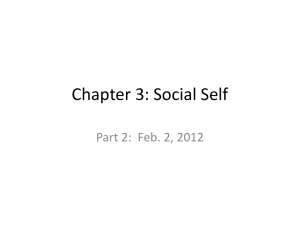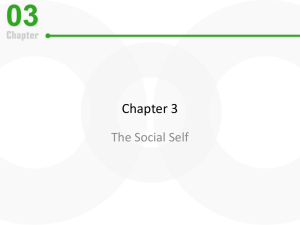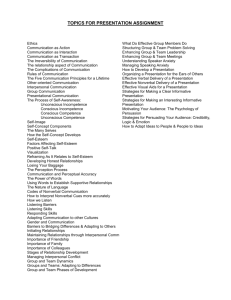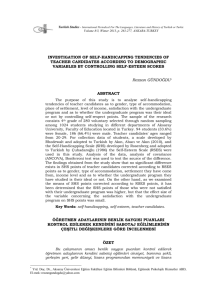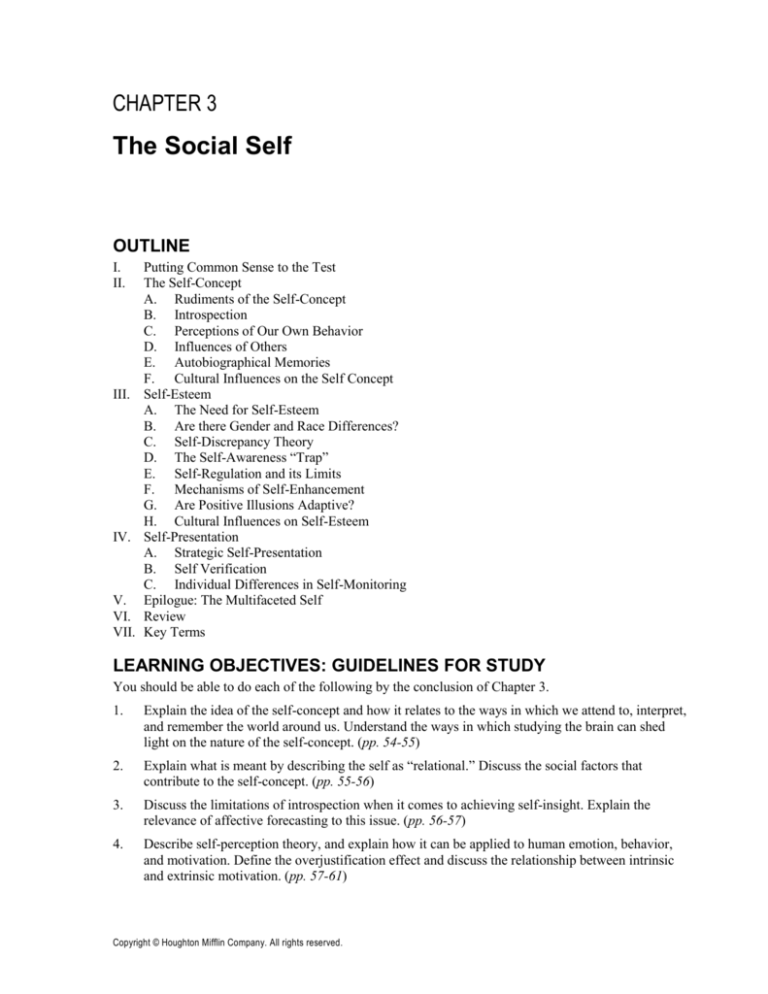
CHAPTER 3
The Social Self
OUTLINE
I.
II.
III.
IV.
V.
VI.
VII.
Putting Common Sense to the Test
The Self-Concept
A. Rudiments of the Self-Concept
B. Introspection
C. Perceptions of Our Own Behavior
D. Influences of Others
E. Autobiographical Memories
F. Cultural Influences on the Self Concept
Self-Esteem
A. The Need for Self-Esteem
B. Are there Gender and Race Differences?
C. Self-Discrepancy Theory
D. The Self-Awareness “Trap”
E. Self-Regulation and its Limits
F. Mechanisms of Self-Enhancement
G. Are Positive Illusions Adaptive?
H. Cultural Influences on Self-Esteem
Self-Presentation
A. Strategic Self-Presentation
B. Self Verification
C. Individual Differences in Self-Monitoring
Epilogue: The Multifaceted Self
Review
Key Terms
LEARNING OBJECTIVES: GUIDELINES FOR STUDY
You should be able to do each of the following by the conclusion of Chapter 3.
1.
Explain the idea of the self-concept and how it relates to the ways in which we attend to, interpret,
and remember the world around us. Understand the ways in which studying the brain can shed
light on the nature of the self-concept. (pp. 54-55)
2.
Explain what is meant by describing the self as “relational.” Discuss the social factors that
contribute to the self-concept. (pp. 55-56)
3.
Discuss the limitations of introspection when it comes to achieving self-insight. Explain the
relevance of affective forecasting to this issue. (pp. 56-57)
4.
Describe self-perception theory, and explain how it can be applied to human emotion, behavior,
and motivation. Define the overjustification effect and discuss the relationship between intrinsic
and extrinsic motivation. (pp. 57-61)
Copyright © Houghton Mifflin Company. All rights reserved.
32
Chapter 3: The Social Self
5.
Explain social comparison theory, identifying when people tend to engage in social comparison
and with whom they tend to compare themselves. Explain the two-factor theory of emotion and its
relevance to social comparison theory. (pp. 61-63)
6.
Discuss autobiographical memories and explain how they are influenced by our self-concept. (pp.
63-64)
7.
Describe the influences of gender, race, and culture on our understanding of self. (pp. 64-67)
8.
Define self-esteem. Explain the basis for the claim that people have a “need for self-esteem.”
Discuss the potential costs associated with the pursuit of self-esteem. (pp. 67-69)
9.
Explain how self-discrepancy theory accounts for the general level of and changes in people’s
self-esteem, and impacts emotional states such as shame, guilt, and anxiety. (pp. 69-70)
10. Identify different types of self-focusing situations and personality types. Explain the selfawareness “trap.” (pp. 70-72)
11. Explain the limitations of self-regulation. Explain what is meant by “ironic processes of selfcontrol” and how this concept relates to self-regulation. (pp. 73-76)
12. Identify four ways that people strive for self-enhancement (i.e., positive illusions) and discuss the
implications of self-enhancement for mental health and the perception of reality. Discuss the
debate regarding whether or not such self-enhancement is adaptive. (pp. 74-82)
13. Compare and contrast strategic self-presentation and self-verification. (pp. 82-85)
14. Describe the differences between people who are high and low in self-monitoring. Explain how
both of these strategies can be useful. (pp. 85-87)
MAJOR CONCEPTS: THE BIG PICTURE
Below are three basic issues or principles that organize Chapter 3. You should know these issues and
principles well.
1.
We have detailed and elaborate knowledge of ourselves – a self-concept. Gaining information
about the self is more difficult than it might first appear, so although our self-impressions are not
always reliable, we gain information about the self from thinking about ourselves, watching
ourselves, comparing ourselves to others, and assimilating to our culture. Once we gain
information about the self, we organize our memories around these beliefs.
2.
We evaluate ourselves; that is, we have a sense of self-esteem. We evaluate ourselves in
comparison to how we think we ought to be and how we think we could ideally be. In addition,
we vary in when and how much we evaluate ourselves. Some situations lead to self-evaluation
more than others, and some people experience more self-evaluation than others. Yet, in general,
we maintain a positive image of ourselves. We are able to think about most situations in ways that
enhance our self-image. Cultural influences play an important role in self esteem.
3.
We present an image of ourselves to others. We usually try to present ourselves so that others will
perceive us in a favorable way, but we also want people to view us accurately.
Copyright © Houghton Mifflin Company. All rights reserved.
Chapter 3: The Social Self
33
KEY TERM EXERCISE: THE CONCEPTS YOU SHOULD KNOW
Below are all of the key terms that appear in boldface in Chapter 3. To help you better understand these
concepts, rather than just memorize them, write a definition for each term in your own words. After
doing so, look at the next section where you’ll find a list of definitions from the textbook for each of the
key terms presented in random order. For each of your definitions, find the corresponding textbook
definition. Note how your definitions compare with those from the textbook.
Key Terms
1.
overjustification effect
2.
self-monitoring
3.
downward social comparison
4.
self-presentation
5.
facial feedback hypothesis
6.
bask in reflected glory (BIRG)
7.
private self-consciousness
8.
self-esteem
9.
self-concept
10. self-perception theory
11. social comparison theory
12. public self-consciousness
13. two-factor theory of emotion
14. self-awareness theory
15. self-handicapping
16. affective forecasting
17. implicit egotism
18. terror management theory
19. self-schemas
Textbook Definitions
a.
Increasing self-esteem by associating with others who are successful.
b.
Defensive tendency to compare ourselves to others who are worse off than we are.
c.
The hypothesis that changes in facial expression can lead to corresponding changes in
emotion.
d.
The theory that people evaluate their own abilities and opinions by comparing themselves to
others.
Copyright © Houghton Mifflin Company. All rights reserved.
34
Chapter 3: The Social Self
e.
Behaviors designed to sabotage one’s performance in order to provide a subsequent excuse
for failure.
f.
The tendency for intrinsic motivation to diminish for activities that have become associated
with reward or other extrinsic factors.
g.
The theory that the experience of emotion is based on two factors: physiological arousal and
a cognitive interpretation of that arousal.
h.
The theory that when internal cues are difficult to interpret, people gain self-insight by
observing their own behavior.
i.
The tendency to change behavior in response to the self-presentation concerns of the
situation.
j.
A personality characteristic of individuals who are introspective, often attending to their own
inner states.
k.
The theory that self-focused attention leads people to notice self-discrepancies, thereby
motivating either an escape from self-awareness or a change in behavior.
l.
An affective component of the self, consisting of a person’s positive and negative selfevaluations.
m.
Strategies people use to shape what others think of them.
n.
A personality characteristic of individuals who focus on themselves as social objects, as seen
by others.
o.
The sum total of an individual’s beliefs about his or her own personal attributes.
p.
People’s difficulty projecting forward and predicting how they would feel in response to
future emotional events.
q.
A nonconscious and subtle form of self-enhancement.
r.
Explains our relentless need for self-esteem.
s.
A belief people hold about themselves that guides the processing of self-relevant
information.
ANSWERS FOR KEY TERM EXERCISE
Answers for the key terms exercise are listed below.
1.
f
2.
i
3.
b
4.
m
5.
c
6.
a
7.
j
8.
l
9.
o
10. h
Copyright © Houghton Mifflin Company. All rights reserved.
Chapter 3: The Social Self
11. d
12. n
13. g
14. k
15. e
16. p
17. q
18. r
19. s
Copyright © Houghton Mifflin Company. All rights reserved.
35
36
Chapter 3: The Social Self
PRACTICE QUIZ: TEST YOUR KNOWLEDGE OF THE CHAPTER
Multiple-Choice Questions
1.
2.
3.
4.
5.
6.
7.
According to the two-factor theory of emotion, the experience of particular emotions requires both
physiological arousal and
a.
public self-consciousness.
b. downward comparison.
c.
a cognitive interpretation.
d. autobiographical memory.
Introspection can impair self-knowledge for behaviors that
a.
consist of flashbulb memories.
b. result from facial feedback.
c.
depend on social comparison.
d. are caused by affective factors.
Herbert has a crush on Beth, but after thinking it over and weighing the pros and cons, he decides
to date Joan instead. Research by Wilson (1985) on the utility of introspection suggests that
Herbert probably would
a.
enjoy dating Beth more than Joan.
b. enjoy dating Joan more than Beth.
c.
enjoy dating Beth in the short run but Joan in the long run.
d. enjoy dating Joan in the short run but Beth in the long run.
As a child, Pete played baseball because it was fun. Now that he is a professional, he receives $1.9
million a year. Given his salary, he will probably experience
a.
social comparison jealousy.
b. choking under pressure.
c.
an overjustification effect.
d. self-handicapping.
Research by McGuire and his colleagues shows that when asked “Who are you?” people
spontaneously rely on
a.
the hindsight bias.
b. self-verification.
c.
distinguishing features.
d. rewards for competence.
Elena spends a lot of time in introspection. She is very much “in touch” with her attitudes, values,
and opinions. Elena is someone who is high in
a.
self-monitoring.
b. self-handicapping.
c.
private self-consciousness.
d. public self-consciousness.
Jennifer is preparing for an important interview. In order to appear upbeat but also to feel upbeat,
she sits alone before the interview and smiles for a while. Jennifer is making use of the
a.
two-factor theory of emotion.
b. self-reference effect.
c.
egocentric bias.
d. facial feedback hypothesis.
Copyright © Houghton Mifflin Company. All rights reserved.
Chapter 3: The Social Self
8.
9.
10.
11.
12.
13.
14.
15.
37
People from western cultures tend to be more ______ than people from eastern cultures.
a.
interdependent
b. compassionate
c.
shy
d. individualistic
Monica thinks that she ought to spend more time with her family, but try as she may, she just
can’t seem to do it and also get her work done. Based on research by Higgins (1989) concerning
the self-concept and self-guides, one can predict that Monica is likely to feel
a.
disappointment.
b. agitation.
c.
envy.
d. shame.
The desire to have others perceive us as we perceive ourselves is called
a.
self-presentation.
b. self-verification.
c.
self-consciousness.
d. self-monitoring.
In their research on optimism and mental health Taylor and Brown (1988) argue that positive
illusions about ourselves can
a.
be serious signs of mental disturbance.
b. lead others to reject us.
c.
cause people to react violently in response to negative feedback.
d. be adaptive in that they promote mental health.
People who drink alcohol often avoid the negative aspects of focusing on themselves and
downplay the discrepancy between their real and ideal self-concepts. This process is called
a.
drunken self-inflation.
b. self-monitoring.
c.
private self-awareness.
d. self-handicapping.
James is a big fan of his college’s football team. After the team wins the league championship,
Jim wears his baseball cap with the college’s logo for a week straight. Jim is probably
a.
high in self-esteem.
b. a high self-monitor.
c.
making downward social comparisons.
d. basking in reflected glory.
Jerry is a high school senior with slightly above-average grades. In order to feel good about his
intellectual abilities, he selects a college with average-ability students. In doing so, Jerry makes it
possible to engage in
a.
BIRGing.
b. overjustification.
c.
downward social comparisons.
d. drunken self-inflation.
During her job interview, Rachel goes out of her way to congratulate her prospective employers
on their successful year and to agree with their strategies for the next fiscal year. Rachel’s
behavior is an example of
a.
the cocktail party phenomenon.
b. the hindsight bias.
c.
ingratiation.
d. basking in reflected glory.
Copyright © Houghton Mifflin Company. All rights reserved.
38
Chapter 3: The Social Self
16. Preoccupied with their self-image, people who are high in self-monitoring go out of their way to
learn about
a.
their autobiographical memory.
b. self-verification strategies.
c.
their self-discrepancies.
d. others with whom they’ll interact.
17. The __________ theory helps explain our relentless need for self-esteem.
a.
terror management
b. self-handicapping
c.
social comparison
d. two-factor
18. People who score on the high-end range on a self-esteem test are most likely
a.
Canadian.
b. Japanese.
c.
Korean.
d. Vietnamese.
19. The desire to have others perceive us as we truly perceive ourselves is a good example of
a.
self-schema.
b. self-esteem.
c.
self-monitoring.
d. self-verification.
Essay Questions
20. Describe how the self-concept develops from the perception of one’s own behavior and from
comparisons with other people.
21. Explain how the self improves and organizes our memories.
22. Describe two ways in which people can enhance their self-image and cope with their faults and
inadequacies. Explain how these self-enhancing biases can promote positive mental health.
23. Describe Terror Management Theory and discuss how it explains modern-day life.
Copyright © Houghton Mifflin Company. All rights reserved.
Chapter 3: The Social Self
39
ANSWERS TO THE PRACTICE QUIZ
Multiple-Choice Questions: Correct Answers and Explanations
1.
c.
a cognitive interpretation. The two factors that the two-factor theory suggests are
necessary and sufficient for an emotional response are physiological arousal and a cognitive label
or a cognitive interpretation of the situation. Schachter emphasized in this model that we are
particularly likely to look to others and their responses in the situation when forming a cognitive
interpretation. Public self-consciousness, downward comparison, and autobiographical memory
are not included in the two-factor theory.
2.
d.
are caused by affective factors. Common sense tells us that introspection should lead to
accurate self-knowledge, but Wilson’s (1985) research suggests that introspection often leads to
inaccurate self-knowledge. False feedback and social comparisons have not been shown to have
an affect on introspection, and flashbulb memories are unrelated to the issue of introspection.
3.
a.
enjoy dating Beth more than Joan. Wilson’s research suggests that introspection often
leads to inaccurate self-knowledge. This research implies that Herbert should probably go with his
gut instinct and go out with Beth rather than Joan. This is true for both the short run and the long
run.
4.
c.
an overjustification effect. Pete used to play baseball for the fun of it (he was intrinsically
motivated). Now he gets paid big money to play. Self-perception theory suggests that, when he
interprets his own behavior, he will now begin to believe that he plays baseball at least partly for
the money. This will undermine his intrinsic motivation—an effect known as overjustification.
There is no reason to expect that he will choke under pressure or that he will engage in social
comparison jealousy or self-handicapping. These processes are unaffected by the salary that he is
earning.
5.
c.
distinguishing features. The research by McGuire and his colleagues shows that, when
spontaneously describing themselves, people tend to point out how they differ from others in their
social environment. For example, a girl in a group of all boys is more likely to describe herself in
terms of her sex than if she were in a group of all girls or in a group with a more equal mix of
boys and girls. Answers to the question “Who are you?” reveal little evidence of the hindsight bias
or of self-verification, and they do not appear to be affected by rewards for competence.
6.
c.
private self-consciousness. People high in private self-consciousness know their attitudes
well and spend a lot of time introspecting about them. Elena seems to be such a person. She
certainly is not someone high in public self-consciousness, concerned with her effects upon
others, and there is no evidence that she is high in self-monitoring or self-handicapping.
7.
d.
facial feedback hypothesis. Research on the facial feedback hypothesis suggests that
people’s facial expressions can often influence their moods. Therefore, smiling might make
Jennifer not only look more upbeat, but also feel more upbeat. The two-factor theory of emotion
suggests that physiological arousal that is labeled cognitively gives rise to emotion. However,
since there was no mention of physiological arousal or a cognitive label, the two-factor theory
would be incorrect. The self-reference effect and the egocentric bias are unrelated to emotion.
8.
d.
individualistic. Research cited in the textbook suggests that people from western cultures
are more individualistic than people from eastern cultures. People in eastern cultures tend to be
more interdependent than westerners. There have been no differences noted in shyness or
compassion between easterners or westerners.
Copyright © Houghton Mifflin Company. All rights reserved.
40
9.
Chapter 3: The Social Self
a.
disappointment. Monica is likely to feel a discrepancy between her ideal self (which wants
to be with her family) and her actual self (which is not spending time with them). Higgins’s
(1989) research on the self-concept and self-guides suggests that such ideal/actual selfdiscrepancies should lead to disappointment. The model does not predict other emotional
reactions such as agitation, envy, and shame.
10. b.
self-verification. Self-verification is the desire to have others perceive us as we truly
perceive ourselves. Self-presentation encompasses the various strategies people use to shape what
others think of them. Self-consciousness occurs when people focus on themselves. This selfconsciousness can be public, where people focus on how others see them, or private, where people
focus on how they see themselves. Self-monitoring is the tendency to change behavior in response
to the self-presentation concerns of the situation.
11. d.
be adaptive in that they promote mental health. Taylor and Brown (1988) argue that
positive illusions are adaptive in that they promote happiness, caring for others, and productive
work—in short, mental health. This view is at odds with what many psychologists previously
claimed: That accurate perceptions of reality are crucial for mental health. More recently, some
have noted the shortcomings to Taylor and Brown’s argument. Colvin and colleagues (1995) have
noted that positive illusions can lead to relationship problems, while Baumeister and colleagues
(1996) have suggested that high self-esteem and its positive illusions may actually lead people to
lash out after negative feedback.
12. a.
drunken self-inflation. Drunken self-inflation is the tendency to discount real and ideal
self-discrepancies when drinking. Drinking is sometimes used as a self-handicapping strategy, but
self-handicapping has little to do with focus of attention. Private self-awareness occurs when
people focus on their self-concepts and is decreased when people drink alcohol, but may or may
not be related to discrepancies between real and ideal self-concepts. As self-monitoring is the
tendency to focus on the immediate social situation and adjust one’s behavior accordingly, it has
little to do with drinking alcohol.
13. d.
basking in reflected glory. Cialdini’s research on basking in reflected glory demonstrates
that people like to identify with groups that they are a part of when those groups succeed. James is
probably basking in reflected glory by identifying himself with the team as it wins. There is little
reason to expect that Jim is high in self-esteem, and his self-esteem could not explain why he
wore his cap more after the team won. Jim is not engaging in downward social comparisons
either; such comparisons involve interactions with others who are doing worse than oneself.
Finally, there is no evidence that James is a high self-monitor.
14. c.
downward social comparisons. Attending a less selective school should give Jerry plenty
of opportunity for contact with others who are not as smart as he is. It should also allow him to
engage in downward social comparisons—comparisons with others that would put him in a
positive light. Such comparisons can be self-enhancing. There is no evidence that Jerry is basking
in reflected glory or engaging in overjustification or drunken self-inflation. These processes have
little or nothing to do with comparisons that allow people to feel good about themselves.
15. c.
ingratiation. Ingratiation is a tactic of strategic self-presentation. It includes such
behaviors as flattery, agreement, and putting one’s best foot forward. If successful, ingratiation
results in liking by others. There is no evidence that Rachel’s behavior exemplifies the cocktail
party phenomenon, the hindsight bias, or basking in reflected glory. These processes have little to
do with flattery and congratulation.
16. d.
others with whom they’ll interact. Since high self-monitors tailor their behavior to fit the
situation they are in, they are very sensitive to the people with whom they interact. They
recognize that other people are an important part of the situation. However, there is little reason to
Copyright © Houghton Mifflin Company. All rights reserved.
Chapter 3: The Social Self
41
expect that self-monitors will try to learn about their autobiographical memories, selfdiscrepancies, or self-verifications. These concepts are probably unrelated to self-monitoring.
17. a.
terror management. Terror management helps to explain our relentless need for selfesteem. According to this theory, we humans are biologically programmed for life and selfpreservation. Yet we are conscious of—and terrified by—the inevitability of our own death. To
cope with this paralyzing, deeply rooted fear, we construct and accept cultural worldviews about
how, why, and by whom the earth was created; religious explanations of the purpose of our
existence; and a sense of history filled with heroes, villains, and momentous events. These
worldviews provide meaning and purpose and a buffer against anxiety.
18. a.
Canadian. Cultures have differing effects on the pursuit of self-esteem. Comparing the
distribution of self-esteem test scores in Canada and Japan, researchers have found that whereas
most Canadians’ scores clustered in the high-end range, the majority of Japanese respondents
scored in the center of that same range.
19. d.
self-verification. People are highly motivated in their social encounters to confirm or
verify their existing self-concept in the eyes of others. Researchers have gathered a great deal of
evidence for this hypothesis and have found that people selectively elicit, recall, and accept
personality feedback that confirms their self-conceptions. In fact, people sometimes bend over
backward to correct others whose impressions are positive but mistaken.
Answers to Essay Questions: Sample Essays
20. Self-perception theory describes how people often infer their beliefs and attitudes from their
actions. This theory suggests that people make inferences about their own behavior in the same
way that they make inferences about other people’s behavior. They assume that if someone
engages in a behavior, then he or she probably has attitudes and beliefs consistent with this
behavior unless there is a good reason to believe otherwise. For example, if someone spends a lot
of time playing basketball, then he or she would probably infer that basketball is an important part
of his or her self-concept. Social comparison theory describes how people develop their attitudes
and behaviors by comparing themselves with others. In particular, it suggests that people make
comparisons with others who are similar, especially those who are doing just slightly better. By
making these comparisons, we gain a sense of what our beliefs and abilities are.
21. Research on the self-reference effect demonstrates that when people encode information in ways
that make it self-relevant (such as thinking about how it relates to themselves), they can remember
that information better. Research on self-schemas shows that people’s self-concepts (or more
precisely their self-schemas) guide and organize their memories. Since these self-schemas are
generally well developed, they make self-relevant information easier to encode when people try to
learn it and easier to retrieve when people try to remember it. In this way the self provides the
structures that organize memory and the mechanisms that improve memory.
22. The main text discusses four ways in which people can enhance their self-image: basking in
reflected glory, downward social comparison, self-handicapping, and self-evaluation maintenance.
Basking in reflected glory occurs when people come to identify with a group that is succeeding.
For example, when a student at a prestigious university points to the accomplishments of the
professors and identifies with them, he or she is able to share in their success. Downward social
comparison entails making contact with others who are doing worse than oneself. This type of
comparison allows one to feel relatively better off. For example, the cancer patient who meets
other patients in worse shape can derive some comfort in the thought that at least he or she is
doing better than they are. Self-handicapping is a strategy that some people use in order to provide
an excuse for poor performance on an upcoming threatening event. For example, the student who
Copyright © Houghton Mifflin Company. All rights reserved.
42
Chapter 3: The Social Self
gets drunk the night before an exam will have a ready explanation for why he or she fails the
exam the next day. Note that while this behavior may soften the negative impact of a poor
performance, it may also cause the poor performance. Tesser’s theory of self-evaluation
maintenance draws on some of the above work but also suggests that people can have different
reactions based on how important the domain is to their self-concept and how close they feel to
people they are comparing themselves with. For example, if John is close to his brother he may
take pride and bask in the reflected glory of his brother’s basketball success if basketball is not
important to John; however, if basketball is important to John and he plays on the same team but
isn’t doing well, he may feel jealousy and anger at his brother’s success. Self-evaluation
maintenance theory suggests that John will either distance himself from his brother or come to see
basketball as less important in this situation. Taylor and Brown present evidence that such selfenhancing biases may be beneficial to our mental health. They suggest that we may need such
biases to cope with the difficult problems we face in daily life. Their evidence suggests that
people who do not show these biases tend to be depressed.
23. According to terror management theory, we humans are biologically programmed for life and
self-preservation. Yet we are conscious of—and terrified by—the inevitability of our own death.
To cope with this paralyzing, deeply rooted fear, we construct and accept cultural worldviews
about how, why, and by whom the earth was created; religious explanations of the purpose of our
existence; and a sense of history filled with heroes, villains, and momentous events. These
worldviews provide meaning and purpose and a buffer against anxiety. In a series of experiments,
investigators found that people react to graphic scenes of death, or to the thought of their own
death, with intense defensiveness and anxiety. When given positive feedback on a test, however,
which boosts their self-esteem, that reaction is muted. This theory has been used to explain how
Americans are likely to cope with the trauma of 9/11 and the terror that it triggered; see
Pyszczynski et al., 2002 for a further discussion.
Copyright © Houghton Mifflin Company. All rights reserved.

